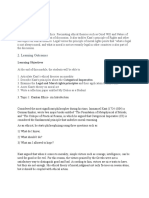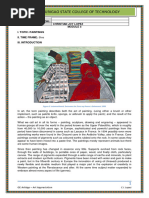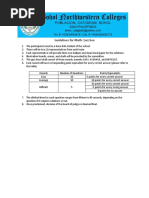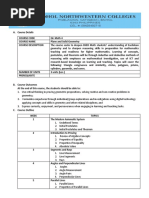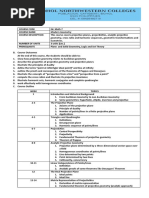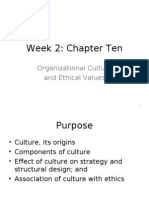Arts Appreciation Module 1 (Week 1) : College Department
Uploaded by
Shiera Saletrero SimbajonArts Appreciation Module 1 (Week 1) : College Department
Uploaded by
Shiera Saletrero SimbajonCOLLEGE DEPARTMENT
ARTS APPRECIATION
Module 1 (Week 1)
Humanities and Arts Appreciation
Introduction
Looking at, making, and writing about art develops critical thinking skills, or a “questioning frame of mind.” Our
culture is increasingly dominated by images: learn to read and understand them fully. Art helps us understand more about
the culture and values that produced it. Art contains information. Creativity is essential in the field of study.
The intellect of humans direct humankind to a more meaningful actions in two different activities: the action to be
done in relation to its ultimate destiny and morality and works to be done in relation to social needs. The necessity of art,
therefore, is in its proper frame for humans to appreciate the beauty of what is around them.
Relevance of Art Appreciation
When you think of art, you might first think of famous woks from artists like van Gogh, Warhol, Picasso, or Monet.
What we often forget is that art has been around since the days of caveman. Art has played a significant role throughout
our history. However, it is also part of our life now from the clothing we wear to the video games we play, the cars we
drive to the covers or pictures in the books or magazines we read. It will continue to be part of our future and the future of
our love ones for many generations to come.
Arts is not meant to be look at only for what it is. It is meant to stimulate thought because it allows viewers to draw
their own emotions and pull from their personal experiences when viewed. It is very powerful in this way and it naturally
develops critical and innovative thinking skills. Art also teaches many important qualities such as listening, observing and
responding to multiple perspectives.
Art appreciation is something art teachers should strive to instill in students. It encompasses so much more than
just looking at a piece of art or learning about the artist. Due to the subjective nature of art, students can learn to construct
meaning and articulate their thoughts when they express, in their own words, their personal opinions about what they are
seeing, feeling and thinking. This allows students an opportunity to develop an open mind and understand that there is
more than just one solution to a problem, having an appreciation for art also helps us to develop an appreciation for each
other how we are all unique in our own way.
Importance of Studying Art and Philosophy
Having an appreciation for art also helps us develop an appreciation for each other and how we are all unique in
our own way.
Talking about arts provides students with a forum for developing their literacy and communication skills.
Promoting their conservations about art help students to develop visual thinking skills when they are able to observe
closely, describe what they see in detail, and also provide evidence for their observations.
Art helps us make sense of our world, and it broadens our experience and understanding. The arts enable us to
imagine the unimaginable, and to connect us to the past, the present and the future, sometimes simultaneously.
Great literature films and visual art transport us to different places and cultures; great art even allows us to see
ourselves and our own community through a different perspective.
“Philosophy” comes from the Greek word meaning “love of wisdom.” Philosophy uses the tool of logic and reason
to analyze the ways in which humans experience the world. It teaches critical thinking, close reading, clear writing, and
logical analysis; it uses these to understand the language we use to describe the world, and our place within it.
Philosophy is an activity people undertake when they seek to understand themselves, the world they live in, and
the relations to the world and each other. Those who study philosophy are engaged in asking, answering, evaluating, and
reasoning about some of life’s most basic, meaningful, and difficult questions about human existence.
Far from being an abstract and useless field, philosophy is among the most practical courses of study taking
philosophy comes from imparts skills that will be useful not only in any career but also in your personal life. The study of
philosophy will enable you to think carefully, critically, and with clarity, take a logical approach to addressing challenging
questions and examining hard issues, reason well and evaluate the reason of others, discuss sensibly and write
effectively.
Philosophy develops intellectual abilities important for life as a whole, beyond the knowledge and skills required
for any particular profession. It enhances analytical, critical, and interpretative capacities that are applicable to any subject
matter and any human context.
Meaning of Humanities and Art Appreciation
Humanities is derived from the Latin word humanus, which means refined or cultured human. The humanities are
study about human culture, such as literature, philosophy and history. Studying the humanities gives you general
knowledge and intellectual skill rather than occupational or professional skills. The humanities provide general knowledge
about the best accomplishments of human beings throughout history. Learning the works of Shakespeare, Plato, and
Beethoven, and our very own Jose Rizal is part of humanities. The humanities make a person educated, but not
necessarily for a specific area of study beyond humanities.
On the other hand, Art Appreciation refers to the knowledge of the general and everlasting qualities that classify
all great art. It is used to refer to the exploration of visual art forms and the introduction of basic principles of visual
literacy. It refers to analyzing the forms of an artwork to general audiences to enhance their enjoyment of such works of
art. It may be analyzed without reference to subject matter, symbolism or historical context. Art appreciation can be
subjective depending on personal preference to aesthetic and form, or it can be based on several elements and principles
1|Page SHIERA S. SIMBAJON
INSTRUCTOR
COLLEGE DEPARTMENT
of design and also depends on social and cultural acceptance. Most of the modern art critics and art historians draw back
from this term, underrating art appreciation as demanding too little serious thought.
Art History
Art history is the study of objects of art in their historical development and stylistic context; that is genre, design,
format and style. The study includes painting, sculpture, architecture, ceramics, furniture and other decorative objects.
As a term, art history, its product being history of art, encompasses several methods of studying visual arts; in
common usage referring to works of arts and architecture.
As a discipline, art history is distinguished from art criticism, which is concerned with establishing a relative artistic
values upon individual works with respect to others of comparable style, or sanctioning in entire style or movement; and
art theory or “philosophy of art”, which is concerned with the fundamental nature of art. One branch of this area of study is
aesthetics, which includes investigating the enigma of the sublime and determining the essence of beauty.
Art history is not only a biographical endeavor. Art historian often root their studies in the scrutiny of individual
objects. They thus attempt to answer in historically specific ways, questions such as; What are key features of this style,
What meaning did this object convey, How does it function visually, Did the artist meet their goals well, What symbols are
involved, and Does it function discursively?
Creativity and Imagination
The biggest difference creativity and imagination is that imagination is thinking of something- whether it is an
object, place, time, etc., that is not present, while creativity is doing something meaningful with your imagination.
Imagination allows us to think of things that are not real or around us at any given time, creativity allows us to do
something meaningful with our imaginations.
Basic Assumptions, Functions, and Nature of Arts
Basic Assumption of Arts
Assumption is a thing that is accepted as true or as certain to happen, without proof.
Art has been created by people at all times, in all countries and it lives because it well-liked and enjoyed.
Art involves experience.
Art is not nature; nature is not art. Art is made by man and nature by God. However nature can be enhanced by
man. The enhanced beauty and artistry of nature, then can be classified as an art.
Art is cultural.
Art is form of creation.
Art is subjective.
Nature of Arts
1. Art is a diverse range of human activities in creating visual, auditory, or performing artworks, expressing
the author’s imaginative or technical skill intended to be appreciated for their beauty or emotional power.
2. Art represents reality.
3. Art is an expression.
4. Art serves as meaning of communication of emotions.
5. Art matters.
6. Art is universal.
7. Art is creation.
Functions of Art
The Personal Function
An artist may create out of a need for self-expression, or gratification. He/ She might have wanted to
communicate a thought or point to the viewer.
The Social Function
One cannot conceive of a society without art, for art is closely related for every aspect of social life. Social
functions of art are those that go beyond personal intrinsic value to art’s social benefits.
Arts perform social function when:
1. Influence Social Behavior (Political Function). It seeks or tends to influence the collective behavior of people.
Example is the “Bayanihan”. Some people that art designed to influence behavior is corrupt, impure, “mere”
propaganda, and so on.
2. Display and Celebration. It is created to be seen or used primarily in public situations like fiestas, parade, etc.
The Physical Function
The physical function of art are often the easiest to understand. Works of art that are created to perform some
service that have physical functions.
1. Form and Function. The function of an object is generally essential in the basic form that it takes.
2. Architecture. The design of the building is determined primarily by its function.
3. Community Planning. Community is group of individuals and families living in a particular locality because of
common interest and needs. Community planning involves the efficient organization of buildings, roads and
spaces so that they meet the physical and aesthetic needs of the community.
Community planning takes into consideration the assignment of areas for proper land use. There are:
a. Residential districts. Special areas are assigned for residential purposes. The present trend is to get away
from overcrowded downtown districts and the attendant problem and settle in areas where it is possible to
blend the charms of rural living with the convenience of urban living.
b. Industrial and commercial areas. These are areas usually located near the source of raw materials.
2|Page SHIERA S. SIMBAJON
INSTRUCTOR
COLLEGE DEPARTMENT
c. Civic centers. A community governs itself; it, therefore provides structures where the functions of
government can be easily carried out and which would, in appearance, be symbolic of community dignity
and pride.
d. Parks, plazas, and malls. The need for a balance between man-made structures and natural areas is
answered in the design of plazas and malls.
e. Streets and roads. Transportation must function with reasonable ease and rapidity from one area to
another.
4. Function and beauty. Many things remain the same in shape throughout the years because their functional
requirements do not allow for greater variations in their form.
EXERCISES:
Essay. Answer the following questions. Use separate sheet of long bondpaper for your answers.
1. If you were and artist, what kind of artist will you be? What art will you explore? Support your answer.
2. Give your insight about why is art not nature.
3. Discuss the difference between imagination and creativity. When do we say man is creative?
4. Who is considered an artist? What does it mean to be an artist?
5. Give your insight about “Art is good because it is universal”.
3|Page SHIERA S. SIMBAJON
INSTRUCTOR
You might also like
- Problem Solving, Mathematical Investigation and Modeling Week 8 Logical Reasoning or Elimination100% (2)Problem Solving, Mathematical Investigation and Modeling Week 8 Logical Reasoning or Elimination2 pages
- Becker - Everyman His Own Historian PDFNo ratings yetBecker - Everyman His Own Historian PDF17 pages
- Unit 1 Lesson 1 What Is Art Introduction and AssumptionNo ratings yetUnit 1 Lesson 1 What Is Art Introduction and Assumption5 pages
- Sensitive and Bias Free Culture and Language100% (1)Sensitive and Bias Free Culture and Language6 pages
- Forming Connection:: "No Generation Has Had The Opportunity, AsNo ratings yetForming Connection:: "No Generation Has Had The Opportunity, As12 pages
- A) Introduction: Article Analysis Template (1 Page To 2 Pages) Times New Roman (Size 12) Spacing (1.5)No ratings yetA) Introduction: Article Analysis Template (1 Page To 2 Pages) Times New Roman (Size 12) Spacing (1.5)2 pages
- Chapter 4 GLOBAL INTERSTATE SYSTEM - Annotated100% (1)Chapter 4 GLOBAL INTERSTATE SYSTEM - Annotated35 pages
- Lesson - 03 - The - Sociological - Self - PPTX (4) (Autosaved)No ratings yetLesson - 03 - The - Sociological - Self - PPTX (4) (Autosaved)20 pages
- Cantilan, Surigao Del Sur - Wikipedia PDFNo ratings yetCantilan, Surigao Del Sur - Wikipedia PDF44 pages
- Topic 1 - What Is Art - Introduction and AssumptionsNo ratings yetTopic 1 - What Is Art - Introduction and Assumptions3 pages
- Interrelationship of Political Science With Other Branches of Learning100% (1)Interrelationship of Political Science With Other Branches of Learning2 pages
- 4 5 Subject Form and Content Ways of Represention of SubjectNo ratings yet4 5 Subject Form and Content Ways of Represention of Subject16 pages
- GE 05 Art Appreciation: Bachelor of Culture and Arts EducationNo ratings yetGE 05 Art Appreciation: Bachelor of Culture and Arts Education10 pages
- Morality and The Human Existence and Key ConceptsNo ratings yetMorality and The Human Existence and Key Concepts6 pages
- Lesson 3.1 Artists, Artisans, and Key Players of The Art MarketNo ratings yetLesson 3.1 Artists, Artisans, and Key Players of The Art Market5 pages
- Shepherdville College: College of Education NSTP - Cwts I Module # 1 Physical Organization and Course OrientationNo ratings yetShepherdville College: College of Education NSTP - Cwts I Module # 1 Physical Organization and Course Orientation7 pages
- Elementary Science Curriculum Physics, Earth, and Space Science100% (1)Elementary Science Curriculum Physics, Earth, and Space Science5 pages
- Teaching Science Iin Elementary Grades (Physics, Earth and Space Science)No ratings yetTeaching Science Iin Elementary Grades (Physics, Earth and Space Science)3 pages
- Mathematics: Quarter 1 - Module 2 Arithmetic Terms, Means and SeriesNo ratings yetMathematics: Quarter 1 - Module 2 Arithmetic Terms, Means and Series11 pages
- Intramurals 2022 Question and Answer (Male Category) : Search For MR & Miss Intramurals PersonalityNo ratings yetIntramurals 2022 Question and Answer (Male Category) : Search For MR & Miss Intramurals Personality4 pages
- Teaching Science in Elementary Grades (Physics, Earth and Space)No ratings yetTeaching Science in Elementary Grades (Physics, Earth and Space)5 pages
- Problem Solving, Mathematical Investigation and Modeling Week 2 Strategies For Solving Problems100% (1)Problem Solving, Mathematical Investigation and Modeling Week 2 Strategies For Solving Problems5 pages
- Teaching Science Iin Elementary Grades (Physics, Earth and Space Science)No ratings yetTeaching Science Iin Elementary Grades (Physics, Earth and Space Science)5 pages
- Teaching Science Iin Elementary Grades (Physics, Earth and Space Science)No ratings yetTeaching Science Iin Elementary Grades (Physics, Earth and Space Science)3 pages
- Problem Solving, Mathematical Investigation and Modeling Week 10 Find A PatternNo ratings yetProblem Solving, Mathematical Investigation and Modeling Week 10 Find A Pattern2 pages
- Arts Appreciation Module 3 (Week 4) The Artist and His Medium A. B. C. D. ENo ratings yetArts Appreciation Module 3 (Week 4) The Artist and His Medium A. B. C. D. E7 pages
- Teaching Science Iin Elementary Grades (Physics, Earth and Space Science)100% (2)Teaching Science Iin Elementary Grades (Physics, Earth and Space Science)4 pages
- Problem Solving, Mathematical Investigation and Modeling Week 1 ObjectivesNo ratings yetProblem Solving, Mathematical Investigation and Modeling Week 1 Objectives4 pages
- Problem Solving, Mathematics Investigation and ModelingNo ratings yetProblem Solving, Mathematics Investigation and Modeling11 pages
- Educ 11 The Teacher and The School Curriculum100% (1)Educ 11 The Teacher and The School Curriculum2 pages
- A. Course Details Course Code Course Name Course DescriptionNo ratings yetA. Course Details Course Code Course Name Course Description2 pages
- Objective Structured Clinical Examination (OSCE) Objective Structured Practical Examination (OSPE)50% (2)Objective Structured Clinical Examination (OSCE) Objective Structured Practical Examination (OSPE)38 pages
- Immersion vs. Interactivity: Virtual Reality and Literary Theory0% (1)Immersion vs. Interactivity: Virtual Reality and Literary Theory29 pages
- Is Age An Important Factor in Relationships?No ratings yetIs Age An Important Factor in Relationships?1 page
- THE STORY of The AGED MOTHER LP and Worksheets89% (9)THE STORY of The AGED MOTHER LP and Worksheets7 pages
- Week 2: Chapter Ten: Organizational Culture and Ethical ValuesNo ratings yetWeek 2: Chapter Ten: Organizational Culture and Ethical Values17 pages
- Possible Coverage For Fil and Eapp MidtermsNo ratings yetPossible Coverage For Fil and Eapp Midterms4 pages
- PERCEPTION-Nature, Laws & Selectivity in PerceptionNo ratings yetPERCEPTION-Nature, Laws & Selectivity in Perception26 pages
- Writing Lesson Plan - Unusual Sports - 7th Grade100% (3)Writing Lesson Plan - Unusual Sports - 7th Grade3 pages
- JenniferDarylSlack BeyondModesBeyondMediaTh 78533-1No ratings yetJenniferDarylSlack BeyondModesBeyondMediaTh 78533-117 pages
- Effectiveness of Modular Distance Learning Modality To The Grade 12 StudentsNo ratings yetEffectiveness of Modular Distance Learning Modality To The Grade 12 Students18 pages






































